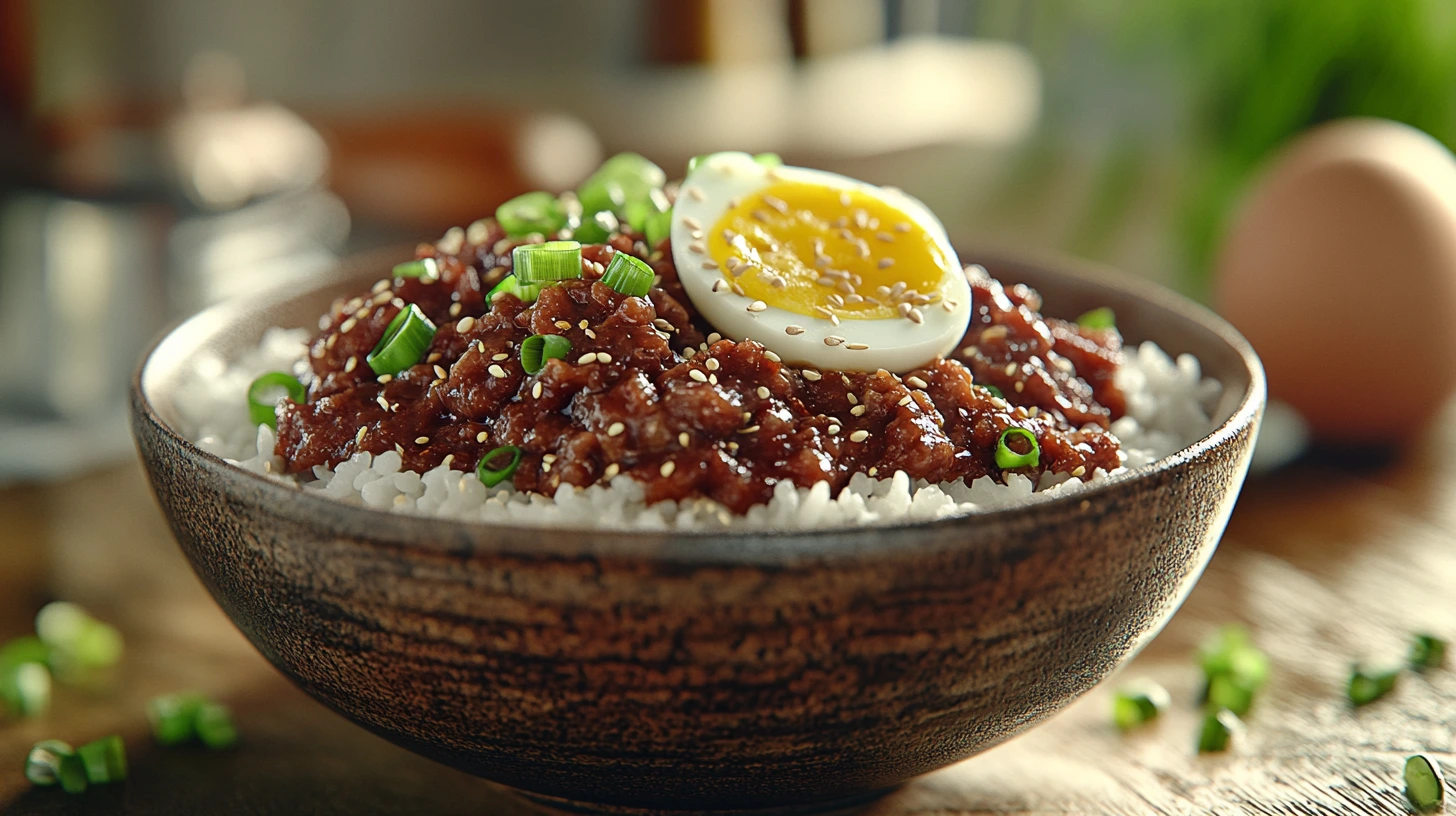The Korean Ground Beef Bowl has taken the internet—and dinner tables—by storm. Packed with bold, savory flavors, it’s the perfect fusion of Korean seasoning and quick American meal prep. Whether you’re trying to spice up your weeknight dinner or just want something that’s equal parts tasty and simple, this dish checks every box.
But what exactly is a Korean Ground Beef Bowl? Imagine sizzling ground beef cooked in a delicious sweet-and-spicy sauce, served over warm rice, and topped with green onions, sesame seeds, and maybe even a runny egg. It’s a one-bowl wonder that feels indulgent while being incredibly easy to make. The best part? It’s done in less than 15 minutes, making it a go-to recipe for busy families, college students, and food lovers alike.
This dish is also highly customizable. Want it spicier? Add more gochujang. Watching your carbs? Swap rice for cauliflower rice. Cooking for kids? Tone down the heat and add a side of fruit. The possibilities are endless, which makes it a favorite for meal preppers and adventurous cooks.
In this article, we’ll dive deep into everything you need to know about the Korean Ground Beef Bowl—from its origins to expert cooking tips, delicious variations, and the best side dishes to serve with it. By the end, you’ll have all the tools you need to make your own version of this viral favorite and impress everyone at your dinner table.
Ready to bring this bold, flavorful dish to life in your kitchen? Let’s get started.
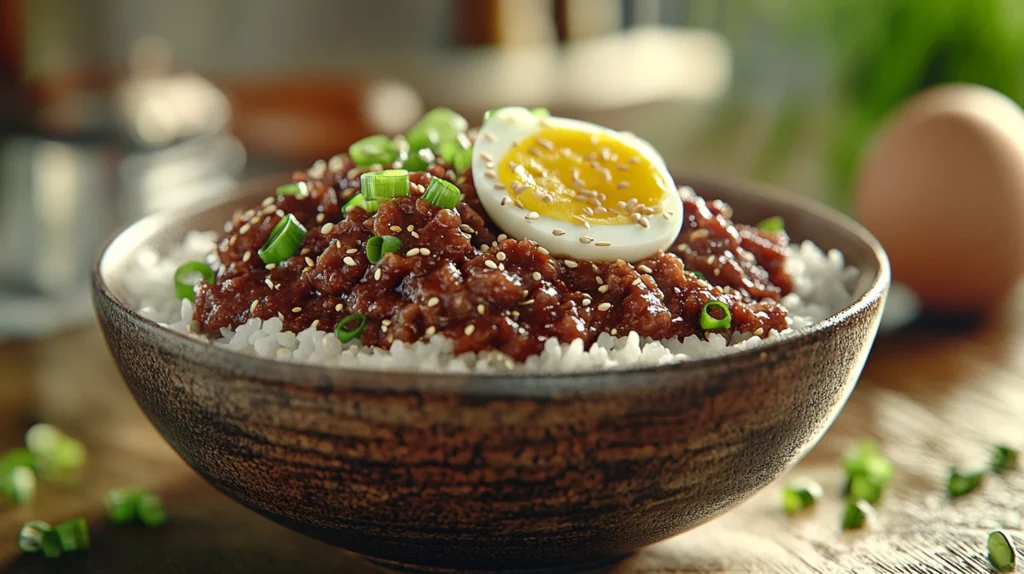
The Origins of the Korean Ground Beef Bowl
Korean Cuisine Background
Korean cuisine has long been celebrated for its bold flavors, vibrant presentation, and harmonious balance of sweet, salty, spicy, and savory. Dishes like bulgogi, bibimbap, and kimchi are iconic staples of Korean food culture. At its core, Korean cooking focuses on fermented ingredients, umami-rich sauces, and balance—both in taste and nutrition.
Traditionally, beef in Korean dishes is thinly sliced and marinated, such as in bulgogi, then grilled or pan-fried. While absolutely delicious, bulgogi can be time-consuming and more expensive due to the quality and type of meat used. This is where the modern twist comes in—using ground beef instead.
American-Korean Fusion
The Korean Ground Beef Bowl is a beautiful product of culinary fusion. Inspired by the flavors of bulgogi, this dish replaces thinly sliced beef with ground beef, which is more budget-friendly and faster to cook. The result? A dish that still captures that sweet, savory, and spicy magic of Korean BBQ but is accessible to just about anyone.
The rise of social media food trends has also played a huge role in this dish’s popularity. Quick recipe videos showcasing the ease of making this bowl have gone viral on platforms like TikTok, YouTube, and Instagram. It’s the kind of meal that looks gourmet but requires minimal effort—a dream come true for busy home cooks.
In the U.S., the Korean Ground Beef Bowl fits seamlessly into weeknight meal planning. It’s part of a growing trend of incorporating international flavors into everyday cooking, making global cuisine more approachable for everyone.
Key Ingredients in a Korean Ground Beef Bowl
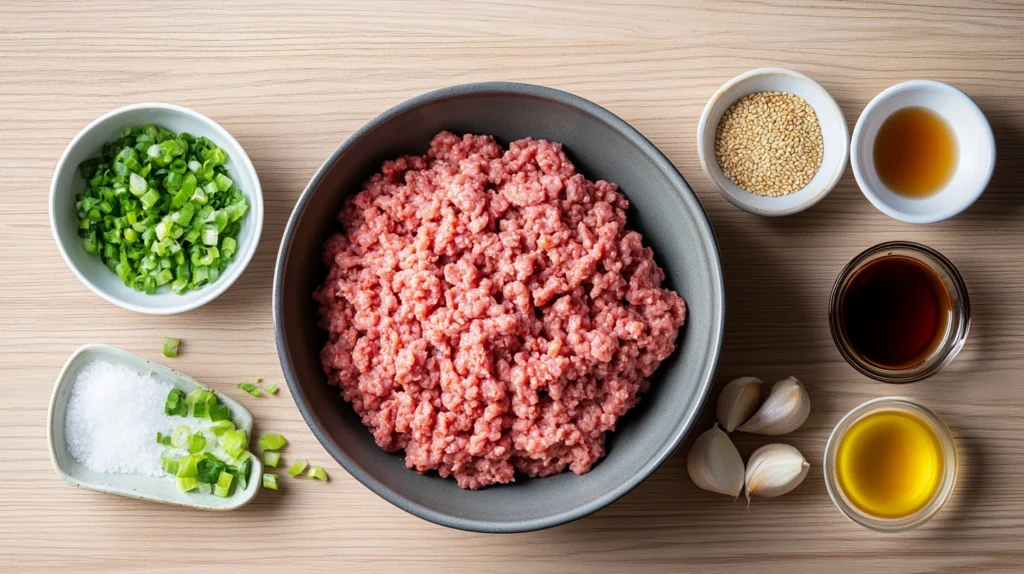
Core Ingredients in a Korean Ground Beef Bowl
Let’s take a closer look at what makes up this delicious bowl. The core ingredients are simple yet powerful in flavor:
- Ground Beef: This is the base of the dish. Opt for 85% lean for a good balance of flavor and fat.
- Soy Sauce: Adds the salty, umami-rich depth typical in Asian dishes.
- Brown Sugar: Balances out the saltiness with a gentle sweetness that mimics the bulgogi flavor.
- Ginger and Garlic: Freshly minced is ideal, but powder works in a pinch. These are key to building that authentic flavor.
- Sesame Oil: A little goes a long way. This adds a nutty aroma that elevates the dish.
- Gochujang or Red Pepper Flakes: For heat. Gochujang is a fermented Korean chili paste that brings complex heat and depth.
- Green Onions: Added at the end for freshness and a pop of color.
- Steamed White Rice: The classic base for the beef. Jasmine or short-grain rice works best.
Popular Ingredient Swaps
One of the best things about the Korean Ground Beef Bowl is how versatile it is. Here are some popular substitutions and swaps:
Protein Alternatives
- Ground Turkey or Chicken: Leaner options for those watching fat intake.
- Tofu or Tempeh: For a vegetarian or vegan version.
- Impossible or Beyond Meat: A great plant-based swap that keeps the meaty texture.
Rice Alternatives
- Cauliflower Rice: Great for low-carb or keto diets.
- Brown Rice or Quinoa: Adds more fiber and a nuttier taste.
- Noodles: Yes, you can turn this into a noodle bowl!
Sauce Substitutes
- Tamari or Coconut Aminos: For a gluten-free soy sauce alternative.
- Honey or Maple Syrup: Instead of brown sugar, for a natural sweetener.
- Sriracha or Chili Garlic Sauce: If gochujang isn’t available, these can be spicy stand-ins.
Garnish and Toppings
The toppings can make or break your bowl. Here are some optional add-ons to customize your dish:
- Fried Egg: A sunny-side-up egg adds richness and texture.
- Sesame Seeds: For crunch and presentation.
- Kimchi: Adds acidity, spice, and probiotics.
- Shredded Carrots or Cucumber: For freshness and a cool contrast.
By adjusting ingredients based on your diet, pantry, or preference, the Korean Ground Beef Bowl becomes not just a meal—but a canvas.
Want a flavorful side to go with it? Try this Easy Roasted Broccoli and Carrots Recipe for a healthy, crispy contrast.
Step-by-Step Korean Ground Beef Bowl Recipe
Quick and Easy Cooking Instructions
One of the biggest draws of the Korean Ground Beef Bowl is just how fast and simple it is to make. Whether you’re a seasoned home chef or a total kitchen newbie, this dish is practically foolproof.
Here’s a quick breakdown of how to make it from start to finish in under 20 minutes.
Ingredients (Serves 4)
- 1 lb ground beef (85% lean)
- 1/4 cup soy sauce (low-sodium recommended)
- 2 tablespoons brown sugar
- 1 tablespoon sesame oil
- 3 cloves garlic, minced
- 1 teaspoon fresh grated ginger (or 1/2 tsp ground ginger)
- 1 tablespoon gochujang (or 1/2 tsp red pepper flakes)
- 1/2 teaspoon black pepper
- 4 cups cooked white rice
- 2 green onions, thinly sliced
- 1 tablespoon sesame seeds (optional)
- Optional toppings: fried egg, shredded carrots, cucumber, kimchi
How to Cook a Korean Beef Rice Bowl in Under 20 Minutes
Prep Your Ingredients
Before you start cooking, it helps to have everything ready. Mince your garlic, slice the green onions, and cook your rice if it’s not already prepared. This mise en place keeps the cooking process smooth and stress-free.
Brown the Beef
Heat a large skillet over medium-high heat. Add the ground beef and cook until it’s browned, breaking it apart with a spatula as it cooks. Drain excess fat if needed, especially if your beef is high in fat content.
Add the Flavor
Once the beef is cooked through, reduce heat to medium. Stir in garlic and ginger and sauté for 1–2 minutes until fragrant. Then, pour in soy sauce, brown sugar, sesame oil, gochujang (or red pepper flakes), and black pepper. Stir everything together until the beef is fully coated in the flavorful sauce.
Let it simmer for 2–3 minutes so the beef absorbs the sauce.
Assemble Your Bowls
Scoop warm rice into bowls and top with the saucy ground beef. Garnish with green onions and sesame seeds. Add any optional toppings like a fried egg or fresh vegetables.
And just like that—you’ve got a restaurant-worthy meal in less time than it takes to order delivery.
Nutritional Value of a Korean Ground Beef Bowl
A Balanced Meal in a Bowl
Don’t let the quick cook time fool you—this dish is more than just convenient. It offers a well-rounded balance of protein, carbs, and healthy fats, especially when served with vegetables or alternative grains.
Here’s a general nutritional breakdown per serving (approximate, based on standard ingredients):
- Calories: 450–550 kcal
- Protein: 22–28g
- Carbohydrates: 35–45g
- Fats: 20–25g
- Sodium: ~700mg (can be reduced with low-sodium soy sauce)
Health Benefits of Korean Style Ground Beef
Ground Beef
Beef is a rich source of protein, iron, and vitamin B12, which are essential for muscle growth, oxygen transport, and energy metabolism. Choosing leaner cuts can help reduce saturated fat intake.
Garlic & Ginger
Both garlic and ginger are celebrated in traditional medicine for their anti-inflammatory and immune-boosting properties. They also aid digestion and add tons of flavor without calories.
Gochujang
This fermented chili paste contains probiotics, antioxidants, and capsaicin, which may boost metabolism and support gut health.
Rice and Veggies
White rice is a fast-absorbing carbohydrate, ideal for energy. For added fiber and nutrition, you can substitute brown rice or add a variety of veggies like spinach, carrots, or bell peppers.
Customization for Diets
Whether you’re following a specific diet or just trying to eat cleaner, this dish can be adapted:
- Low-Carb/Keto: Use cauliflower rice and a sugar substitute.
- Gluten-Free: Swap soy sauce with tamari or coconut aminos.
- Vegetarian/Vegan: Use crumbled tofu or plant-based meat and veggie stock.
This flexibility makes the Korean Ground Beef Bowl a nutrient-dense, customizable option for just about anyone.
If you enjoy spicy, globally inspired food, you’ll definitely appreciate the complexity of this Jamaican Curry Chicken—another bold and vibrant weeknight winner.
Easy Korean Ground Beef Bowl Variations
One of the best things about the Korean Ground Beef Bowl is how adaptable it is. Whether you’re catering to dietary needs, switching things up for fun, or feeding picky eaters, you can tweak this recipe to suit just about any preference.
Spicy Korean Ground Beef Rice Bowl
If you love heat, crank it up! Here are a few ways to add more spice:
- Double the gochujang for a bolder, fermented chili kick.
- Add a splash of sriracha or a sprinkle of Korean red chili flakes (gochugaru).
- Garnish with thinly sliced fresh red chili peppers.
Pairing it with a fried egg can help balance the heat while still giving you that fiery thrill.
Vegetarian Korean Beef Bowl
You don’t have to eat meat to enjoy this bold, flavorful bowl.
- Replace ground beef with crumbled tofu, tempeh, or a plant-based ground beef alternative.
- Swap out fish sauce (if using) for mushroom or soy-based umami sauces.
- Use vegan gochujang (some varieties contain anchovies) and ensure your sugar is bone-char-free.
It’s just as satisfying and loaded with flavor.
Keto-Friendly Korean Ground Beef Bowl Recipe
Looking to reduce carbs but still enjoy this comfort food? No problem.
- Use cauliflower rice or shredded cabbage as a base instead of white rice.
- Substitute brown sugar with a low-carb sweetener like erythritol or monk fruit.
- Choose a fattier cut of ground beef (like 80/20) for better macro balance.
This version is perfect for anyone following a keto or paleo lifestyle.
Gluten-Free Korean Ground Beef Stir Fry
Soy sauce and gochujang often contain gluten. To make it gluten-free:
- Replace soy sauce with tamari, liquid aminos, or coconut aminos.
- Make sure to check labels on your gochujang and other sauces for hidden gluten.
With a few simple swaps, you can make a bowl that’s completely gluten-free and still packed with flavor.
How to Meal Prep Korean Ground Beef Bowls
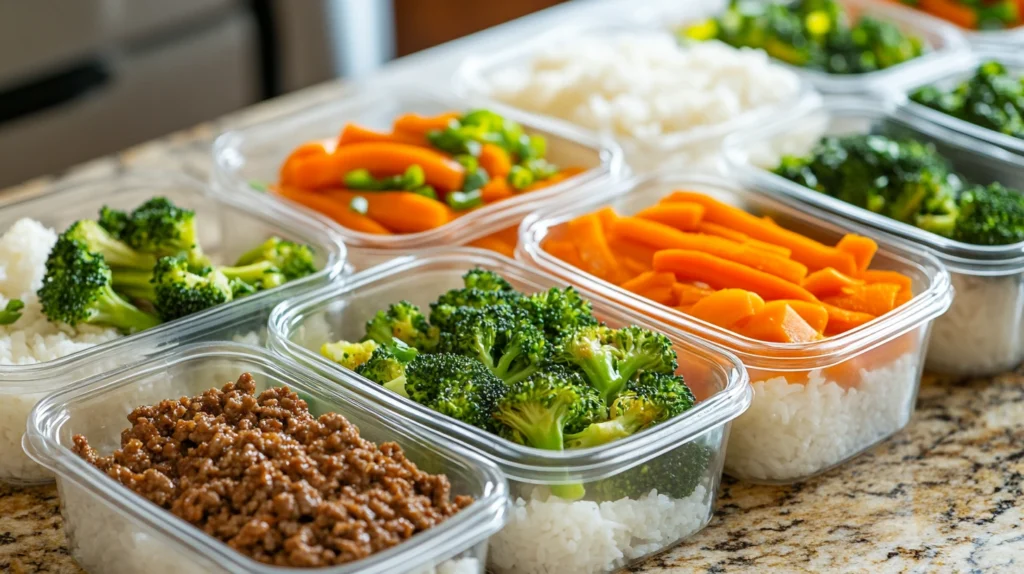
If you’re all about saving time during the week, this dish is a meal-prepper’s dream. It stores well, reheats beautifully, and is easy to portion out into individual containers.
Prep Once, Eat All Week
Here’s how to do it:
Cook in Bulk
- Double or triple the ground beef recipe.
- Cook a large batch of rice (or your favorite base).
- Portion everything into airtight containers.
Each container should have rice on one side, beef on the other, with optional veggies in a third section if you’re using a bento-style box.
Storage Tips
- Refrigerator: Store in airtight containers for up to 4 days.
- Freezer: Freeze for up to 2 months. Just make sure to cool the beef completely before freezing.
Label and date your containers to keep things organized.
Reheating
- Microwave for 2–3 minutes, or until warmed through.
- Add a splash of water or soy sauce before reheating to prevent dryness.
- Top with fresh green onions or sesame seeds after heating.
This makes it a great grab-and-go lunch or a no-fuss dinner.
Side Dishes to Serve with a Korean Ground Beef Bowl
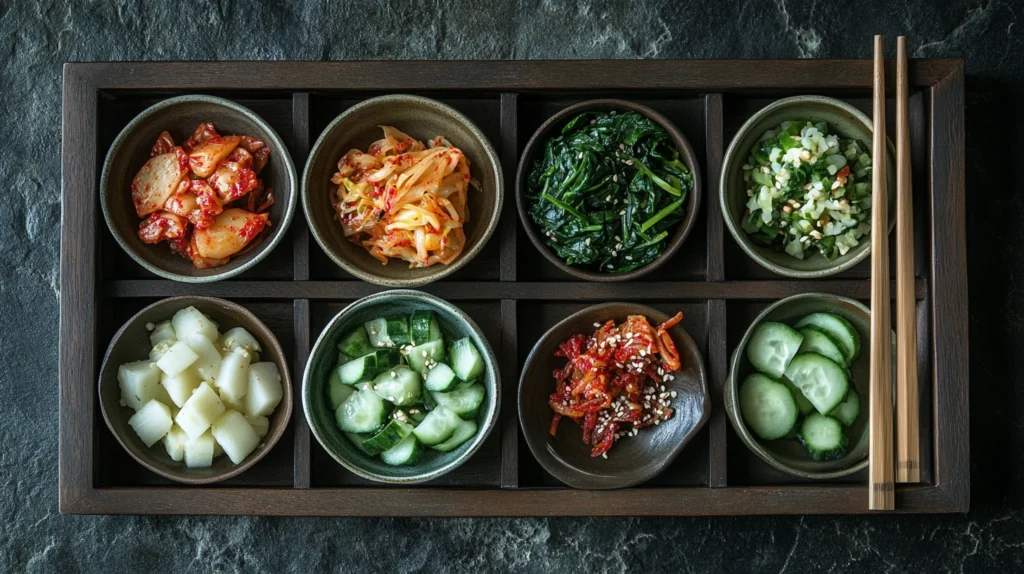
A Korean Ground Beef Bowl is a full meal on its own, but pairing it with the right sides can take it to the next level. These accompaniments add texture, contrast, and authenticity to the dish.
Classic Korean Side Dishes (Banchan)
Kimchi
This fermented cabbage side dish is spicy, sour, and full of gut-friendly probiotics. It adds a crunchy, acidic contrast that complements the savory beef perfectly.
Pickled Vegetables
Pickled radish or carrots offer a cool, crisp bite that balances the richness of the meat. They’re also super easy to make at home.
Japchae (Korean Glass Noodles)
If you’re serving this bowl for guests, pair it with japchae—a savory-sweet noodle dish made with sweet potato starch noodles, vegetables, and sesame oil.
Western-Style Sides That Work
- Simple Green Salad: A light salad with sesame vinaigrette balances out the richness.
- Roasted Vegetables: Think carrots, broccoli, or Brussels sprouts.
- Cucumber Salad: A cold, tangy cucumber salad refreshes the palate.
These sides add color, variety, and extra nutrition to your meal while keeping prep time minimal.
Korean Ground Beef Bowl vs. Traditional Bulgogi
What is Bulgogi?
Bulgogi is a traditional Korean dish that features thin slices of marinated beef, usually ribeye or sirloin, grilled or pan-fried to perfection. The marinade typically includes soy sauce, sugar, garlic, sesame oil, and pear juice or grated pear for tenderizing.
Bulgogi translates to “fire meat,” referring to how it’s traditionally grilled over an open flame. It’s deeply flavorful, slightly sweet, and incredibly tender.
How the Ground Beef Bowl Compares
While both dishes share similar flavor profiles, the Korean Ground Beef Bowl is a modern, simplified version of bulgogi. Here’s how they differ:
| Feature | Bulgogi | Korean Ground Beef Bowl |
|---|---|---|
| Beef Cut | Thinly sliced ribeye/sirloin | Ground beef |
| Cooking Time | Marinate for hours, then grill or pan-fry | Cook in under 15 minutes |
| Preparation | Requires slicing and marinating | Simple mix-and-cook |
| Cost | More expensive due to beef cut | Budget-friendly |
| Flavor Intensity | Deep, complex, slightly smoky | Bold, saucy, and savory |
If bulgogi is the elegant dinner party entrée, the Korean Ground Beef Bowl is its equally delicious weeknight cousin. Both deliver amazing Korean flavor; one just takes a little less effort.
Tips for the Best Korean Ground Beef Bowl Flavor
Getting that balance of sweet, savory, spicy, and umami can turn a good bowl into an unforgettable one. Here are some tried-and-true tips:
Use Fresh Garlic and Ginger
Powdered versions are fine in a pinch, but fresh minced garlic and grated ginger bring a much more vibrant and authentic taste.
Don’t Skimp on Sesame Oil
A drizzle of toasted sesame oil adds that deep nutty aroma that gives the bowl its signature finish. It’s added at the end of cooking or used as a garnish—not a cooking oil.
Balance the Sweet and Spicy
If it’s too sweet, add more soy sauce or gochujang. Too salty? A bit more brown sugar or honey can smooth it out. Taste as you go, and adjust based on your preferences.
Add Texture with Toppings
A soft egg, crispy kimchi, and crunchy veggies can add layers of texture that make each bite more exciting. Don’t underestimate the power of garnishes!
Common Korean Ground Beef Bowl Cooking Mistakes to Avoid
Even a simple dish like this has its pitfalls. Here are the most common mistakes and how to avoid them:
Overcooking the Beef
Ground beef cooks quickly. Overcooking it can make it dry and chewy. Cook just until browned, and then simmer in the sauce for flavor without overdoing it.
Using Low-Quality Soy Sauce
Soy sauce is the backbone of the dish. Using a cheap, salty version can overpower the flavor. Opt for a low-sodium, naturally brewed soy sauce for best results.
Not Draining Excess Fat
Especially with higher-fat ground beef, too much grease can make the dish oily. Drain the excess fat after browning the beef to keep the final product clean and flavorful.
Skipping the Rice or Base
The rice isn’t just filler—it absorbs the sauce and balances the intense flavors. Skipping it can make the dish feel too salty or strong. If you’re not using rice, make sure your alternative base is hearty enough to balance the beef.
Make a Kid-Friendly Korean Beef Rice Bowl
Kids can be picky, especially when it comes to spice or unfamiliar ingredients. Here’s how to tweak the Korean Ground Beef Bowl to be a kid-approved hit:
Tone Down the Spice
- Reduce or eliminate the gochujang.
- Add a teaspoon of ketchup or BBQ sauce for a more familiar flavor.
- Skip red pepper flakes altogether.
Use Simple, Familiar Toppings
- Try shredded cheese, sweet corn, or mild veggies like peas or carrots.
- Let kids build their own bowls with small toppings in separate dishes—this adds fun and gives them control.
Serve With Fruit or Mild Sides
- Sliced apples or oranges can provide a sweet balance to the meal.
- A side of steamed rice and a hard-boiled egg is gentle and nutritious.
Sneak in Veggies
Mix finely chopped veggies like carrots, zucchini, or spinach directly into the beef as it cooks. They’ll absorb the sauce and blend in easily.
This kid-friendly version still captures the essence of the dish but keeps it mild and approachable for even the youngest eaters.
And don’t forget to check out something indulgent for dessert—like this Strawberries & Cream Delight for a sweet, refreshing finish to your Korean-inspired meal.
Frequently Asked Questions
What to serve with a Korean beef bowl?
A Korean Ground Beef Bowl is a flavor-packed main dish, but pairing it with the right sides can take the meal to a whole new level. Here are some of the most popular and delicious accompaniments:
- Kimchi: The classic fermented cabbage side is spicy, tangy, and full of probiotics. It balances out the richness of the beef beautifully.
- Steamed or Fried Egg: A runny yolk adds creaminess and visual appeal.
- Pickled Vegetables: Pickled daikon, carrots, or cucumbers add crunch and acidity.
- Simple Green Salad: A light salad with sesame dressing can balance the meal and provide freshness.
- Miso Soup or Doenjang Jjigae: A light soup works well to round out the meal with something warm and comforting.
These sides not only add variety but also enhance the nutritional value and authentic Korean dining experience.
What is a Korean ground beef bowl called?
While there isn’t a traditional Korean name for a “Korean Ground Beef Bowl” as it’s a modern fusion dish, it’s most commonly referred to in English-speaking communities as:
- Korean Ground Beef Bowl
- Korean Beef Rice Bowl
- Quick Bulgogi Bowl (though technically, it’s not true bulgogi)
In Korean cuisine, rice bowls are often referred to as “bap” dishes. For example, bibimbap means “mixed rice.” A Korean ground beef bowl could loosely be called something like soegogi-deopbap (쇠고기덮밥), which means “beef over rice.”
However, because this dish uses ground beef and simplified sauces, it’s typically considered a Korean-American or Korean-inspired meal rather than an authentic traditional dish.
What does Korean beef taste like?
Korean-style beef, especially when inspired by bulgogi flavors, has a rich, umami-forward profile with a beautiful balance of sweet, salty, and slightly spicy notes.
Here’s how to describe the flavor:
- Savory (Umami): From soy sauce and garlic.
- Sweet: Thanks to brown sugar, honey, or even fruit-based marinades.
- Nutty: A hint of sesame oil adds warm, roasted notes.
- Spicy (optional): From gochujang or red pepper flakes, depending on your spice level.
It’s tender, juicy, and full of flavor. Even if it’s made with ground beef instead of sliced steak, the flavor remains bold and satisfying, making it popular across cultures and age groups.
What are the spices in a Korean beef bowl?
The typical spices and seasonings used in a Korean Ground Beef Bowl create that iconic sweet-spicy-savory blend. Here’s a breakdown:
- Garlic: Fresh minced garlic adds a deep, aromatic base.
- Ginger: A hint of ginger gives warmth and a subtle zing.
- Gochujang: A fermented Korean chili paste that adds spice, sweetness, and umami.
- Soy Sauce: The core seasoning, providing saltiness and umami depth.
- Brown Sugar: Balances the salt and enhances the caramelized flavor.
- Sesame Oil: Adds richness and a nutty aroma (used as a finishing oil).
- Red Pepper Flakes (optional): For those who want to turn up the heat.
- Black Pepper: A mild background spice for added depth.
These ingredients combine to form the signature flavor of Korean beef bowls—comforting, bold, and slightly addictive.
Conclusion
The Korean Ground Beef Bowl isn’t just another trendy dish—it’s a perfect example of how culinary fusion can bring together flavor, speed, nutrition, and accessibility in a single bowl. Whether you’re a busy parent, a student on a budget, or someone who just loves bold flavors with minimal effort, this recipe is your new best friend.
In less than 20 minutes, you can create a meal that’s packed with protein, rich in taste, and endlessly customizable. From spicy gochujang-infused versions to vegetarian and gluten-free alternatives, the Korean Ground Beef Bowl proves that quick meals don’t have to be boring or bland. Add a few vibrant sides like kimchi or cucumber salad, and you’ve got a complete Korean-inspired dinner that rivals any restaurant plate.
We’ve walked through everything—from the dish’s cultural roots to cooking tips, nutritional benefits, variations, and kid-friendly options. Now it’s your turn. Pick your ingredients, fire up that skillet, and create a delicious, homemade Korean Ground Beef Bowl that your whole family will love.
And don’t forget: food is always more fun when you make it your own. Try out new toppings, experiment with spice levels, and turn this meal into a regular favorite. Happy cooking!

Korean Ground Beef Bowl
Equipment
- Large skillet or frying pan
- Wooden spoon or spatula
- Measuring spoons and cups
- Rice cooker or pot (for rice)
- Cutting board and knife
Ingredients
- 1 lb 450g ground beef (85% lean recommended)
- 1/4 cup low-sodium soy sauce
- 2 tablespoons brown sugar
- 1 tablespoon sesame oil
- 3 cloves garlic minced
- 1 teaspoon fresh grated ginger or 1/2 tsp ground ginger
- 1 tablespoon gochujang or 1/2 tsp red pepper flakes
- 1/2 teaspoon black pepper
- 4 cups cooked white rice jasmine or short grain
- 2 green onions sliced (for garnish)
- 1 tablespoon sesame seeds optional garnish
- Optional toppings: fried egg shredded carrots, cucumber slices, kimchi
Instructions
- Cook the Ground Beef:
- In a large skillet over medium-high heat, cook ground beef until fully browned, breaking it apart with a spatula. Drain excess fat if necessary.
- Add Garlic and Ginger:
- Reduce heat to medium. Stir in the minced garlic and grated ginger. Cook for 1–2 minutes until fragrant.
- Make the Sauce:
- Add soy sauce, brown sugar, sesame oil, gochujang (or red pepper flakes), and black pepper to the beef. Stir well to coat and simmer for 2–3 minutes until the sauce thickens slightly.
- Assemble the Bowls:
- Scoop rice into serving bowls. Top with the cooked Korean ground beef. Add green onions, sesame seeds, and any desired toppings.
- Serve Immediately:
- Serve hot, and enjoy with a side of kimchi or your favorite vegetables.
Notes
Add vegetables like shredded carrots or spinach directly into the skillet to boost nutrition.
Gochujang adds complex heat, but you can reduce it or replace with red pepper flakes to control the spice level.
Make it ahead and store in airtight containers for up to 4 days in the fridge.

